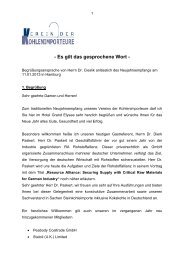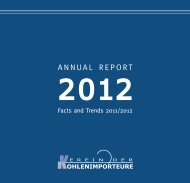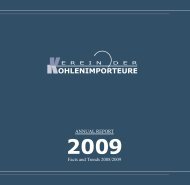Annual Report 2010 - Verein der Kohlenimporteure eV
Annual Report 2010 - Verein der Kohlenimporteure eV
Annual Report 2010 - Verein der Kohlenimporteure eV
Create successful ePaper yourself
Turn your PDF publications into a flip-book with our unique Google optimized e-Paper software.
Urbanization and Industrialization Drive Chinese and Indian Coal Demand<br />
Pl a nn e d Ur b a ni z a t i o n in I n d i a in M illi o n Pl a nn e d Ur b a ni z a t i o n in China in Million<br />
214<br />
315<br />
+215<br />
1990 2005 2025 1990 2005<br />
2025<br />
Total population in million 839 1106 1401 1149 1307 1435<br />
Urbanization in % 25 29 38 27 41 64<br />
Figure 2 Source: McKinsey <strong>2010</strong><br />
These figures make it clear why emerging and<br />
developing countries are currently unable to join<br />
Europe’s industrialised countries in achieving the<br />
latter’s priorities to save energy and reduce greenhouse<br />
gas emissions. Satisfying the basic needs of their<br />
citizens for food, water, mobility and access to electric<br />
power to improve their living standards, even to a<br />
modest level, remains their top priority.<br />
Global Energy Consumption Increased<br />
Again<br />
530<br />
Initial estimates indicate that world energy consumption<br />
in <strong>2010</strong> reached the level of 2008. The reason behind<br />
315<br />
572 +354<br />
926<br />
this is the global recovery from the economic crisis,<br />
notably in the OECD countries.<br />
The Pacific region continued to enjoy economic<br />
growth. In addition to the increase of its own energy<br />
production, especially China and India made increasing<br />
use of energy supplies available from the world market.<br />
Oil consumption increased by 4.6% and natural gas<br />
<br />
<br />
hard coal accounting for most of this growth.<br />
In <strong>2010</strong>, coal (hard coal and lignite) reached a world<br />
market share of 32% (total does not include non-hydro<br />
renewables) and has continued to be the fastest-growing<br />
source of primary energy over the past several years.<br />
Primary Energy Consumption - Major Sources of Energy -<br />
2000<br />
Mtce<br />
2008<br />
Mtce<br />
Total 13,132 16,151 15,900 16,580 4.3<br />
HT-W2 Source: BP, own estimate for <strong>2010</strong><br />
2009<br />
Mtce<br />
<strong>2010</strong><br />
Mtce<br />
2009/<strong>2010</strong><br />
Change in %<br />
Coal 3,120 4,724 4,900 5,230 6.7<br />
Natural Gas 3,180 3,898 3,700 3,800 2.7<br />
Oil 5,110 5,617 5,400 5,650 4.6<br />
Nuclear 840 886 900 900 0.0<br />
Hydro 882 1,026 1,000 1,000 0.0<br />
11








